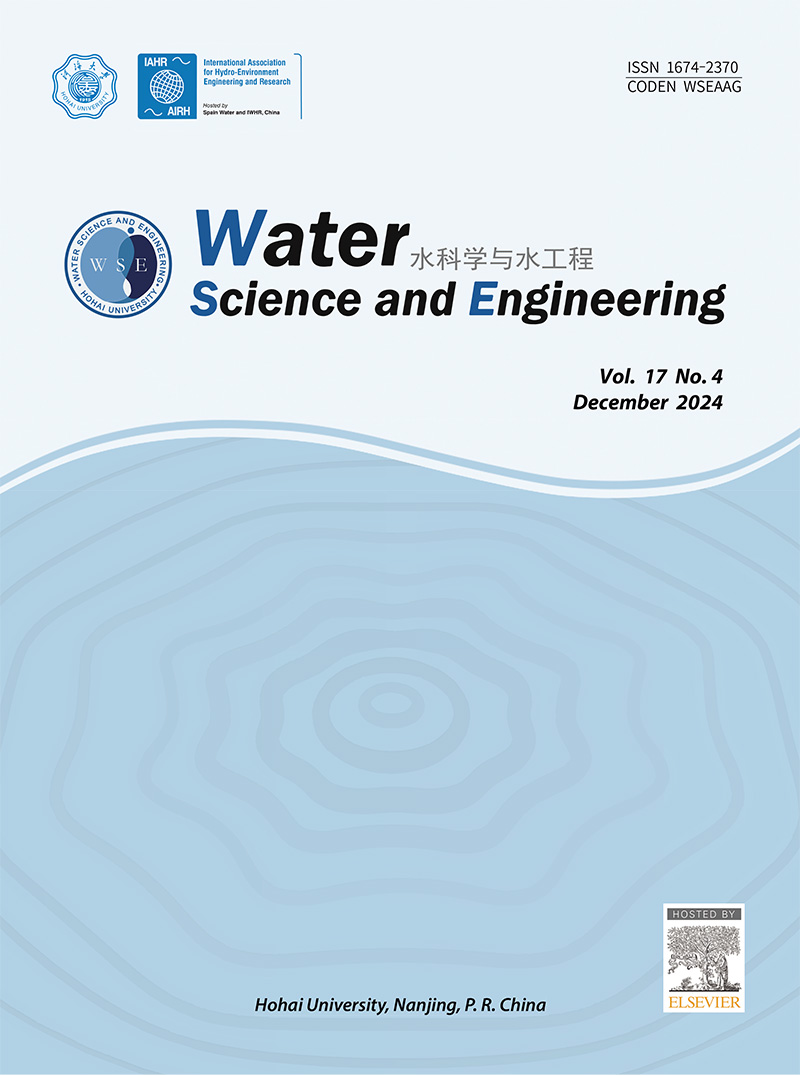Superior decomposition of xenobiotic RB5 dye using three-dimensional electrochemical treatment: Response surface methodology modelling, artificial intelligence, and machine learning-based optimisation approaches
IF 4.3
Q1 WATER RESOURCES
引用次数: 0
Abstract
The highly efficient electrochemical treatment technology for dye-polluted wastewater is one of hot research topics in industrial wastewater treatment. This study reported a three-dimensional electrochemical treatment process integrating graphite intercalation compound (GIC) adsorption, direct anodic oxidation, and ·OH oxidation for decolourising Reactive Black 5 (RB5) from aqueous solutions. The electrochemical process was optimised using the novel progressive central composite design–response surface methodology (CCD–NPRSM), hybrid artificial neural network–extreme gradient boosting (hybrid ANN–XGBoost), and classification and regression trees (CART). CCD–NPRSM and hybrid ANN–XGBoost were employed to minimise errors in evaluating the electrochemical process involving three manipulated operational parameters: current density, electrolysis (treatment) time, and initial dye concentration. The optimised decolourisation efficiencies were 99.30%, 96.63%, and 99.14% for CCD–NPRSM, hybrid ANN–XGBoost, and CART, respectively, compared to the 98.46% RB5 removal rate observed experimentally under optimum conditions: approximately 20 mA/cm2 of current density, 20 min of electrolysis time, and 65 mg/L of RB5. The optimised mineralisation efficiencies ranged between 89% and 92% for different models based on total organic carbon (TOC). Experimental studies confirmed that the predictive efficiency of optimised models ranked in the descending order of hybrid ANN–XGBoost, CCD–NPRSM, and CART. Model validation using analysis of variance (ANOVA) revealed that hybrid ANN–XGBoost had a mean squared error (MSE) and a coefficient of determination (R2) of approximately 0.014 and 0.998, respectively, for the RB5 removal efficiency, outperforming CCD–NPRSM with MSE and R2 of 0.518 and 0.998, respectively. Overall, the hybrid ANN–XGBoost approach is the most feasible technique for assessing the electrochemical treatment efficiency in RB5 dye wastewater decolourisation.
利用三维电化学处理技术优化异生物 RB5 染料的分解:响应面方法建模、人工智能和基于机器学习的优化方法
染料废水的高效电化学处理技术是工业废水处理领域的研究热点之一。本文报道了一种集石墨插层化合物(GIC)吸附、直接阳极氧化和·OH氧化为一体的三维电化学处理工艺,用于脱色活性黑5 (RB5)的水溶液。采用新型渐进式中心复合设计-响应面法(CCD-NPRSM)、混合人工神经网络-极端梯度增强法(hybrid ANN-XGBoost)和分类与回归树(CART)对电化学过程进行了优化。采用CCD-NPRSM和混合型ANN-XGBoost来最大限度地减少评估电化学过程的误差,包括三个操作参数:电流密度、电解(处理)时间和初始染料浓度。优化后的CCD-NPRSM、ANN-XGBoost和CART的脱色效率分别为99.30%、96.63%和99.14%,而实验结果显示,在最佳条件下,电流密度约为20 mA/cm2,电解时间为20 min, RB5浓度为65 mg/L,脱色率为98.46%。基于总有机碳(TOC)的不同模型,优化的矿化效率在89%到92%之间。实验研究证实,优化后模型的预测效率依次为ANN-XGBoost、CCD-NPRSM和CART混合模型。方差分析(ANOVA)表明,混合ANN-XGBoost去除RB5的均方误差(MSE)和决定系数(R2)分别约为0.014和0.998,优于CCD-NPRSM, MSE和R2分别为0.518和0.998。综上所述,ANN-XGBoost混合方法是评估RB5染料废水脱色电化学处理效率的最可行技术。
本文章由计算机程序翻译,如有差异,请以英文原文为准。
求助全文
约1分钟内获得全文
求助全文
来源期刊

Water science and engineering
WATER RESOURCES-
CiteScore
6.60
自引率
5.00%
发文量
573
审稿时长
50 weeks
期刊介绍:
Water Science and Engineering journal is an international, peer-reviewed research publication covering new concepts, theories, methods, and techniques related to water issues. The journal aims to publish research that helps advance the theoretical and practical understanding of water resources, aquatic environment, aquatic ecology, and water engineering, with emphases placed on the innovation and applicability of science and technology in large-scale hydropower project construction, large river and lake regulation, inter-basin water transfer, hydroelectric energy development, ecological restoration, the development of new materials, and sustainable utilization of water resources.
 求助内容:
求助内容: 应助结果提醒方式:
应助结果提醒方式:


